Abstract
The challenges of limited cropland resources and ecological degradation in grain-producing areas were addressed in this study within the broader context of China’s ecological civilization and dual carbon goals. An integrated framework was employed, applying the three-dimensional ecological footprint (EF3d) model, enhanced by carbon footprint improvement, to assess cropland at the provincial, municipal, and county levels. The analysis indicated a rise in both carbon absorption and emissions, resulting in a carbon surplus. Since 1984, chemical fertilizers have been identified as the predominant source of carbon emissions. Carbon absorption was found to vary distinctly among the four crops. Additionally, carbon fluxes displayed notable spatial and temporal variability. The ecological deficit persisted, showing distinct spatial clustering. Moreover, the cropland ecological footprint breadth (EFsize) was found to exhibit a pattern of decrease–increase–decrease, while cropland occupation remained high. The ecological footprint depth (EFdepth) consistently surpassed the threshold of 1. Spatially, the distribution pattern of cropland EFsize was opposite to that of EFdepth; the centroid of per capita cropland EFdepth underwent a significant spatial shift. The cropland EF3d was observed to experience a downward trend, with considerable regional disparities. Furthermore, unsustainable use of cropland was observed across multiple scales. This research provides an empirical foundation for promoting advancing ecological agriculture and sustainable cropland use practices.
1. Introduction
Cropland is an essential component of natural capital and a crucial resource for human survival and development [1]. In addition to providing supply services, such as food production, cropland also offers a range of ecological functions, including supporting, regulatory, and cultural services [2]. Currently, cropland has become the second most significant source of greenhouse gas emissions globally. With the gradual increase in agricultural scale and cropland use efficiency, agricultural inputs like pesticides, irrigation, fertilizers, and machinery have caused a rapid rise in agricultural ecological pressures [3]. This intensification of agricultural practices has also resulted in increasingly severe issues such as soil pollution and land degradation. Despite China’s continuous efforts to strengthen cropland resource protection and implement stringent strategies for safeguarding both the quantity and quality of cropland, such as the “quantity-quality-ecology” integrated protection strategy, the issue of cropland ecological security remains significant [4]. Unreasonable use of cropland and intense human disturbances have surpassed the self-regulation capacity of cropland resources, thereby affecting the security of cropland ecosystems and threatening sustainable cropland management and food supply stability [5]. A key indicator for assessing resource sustainability is the ecological footprint, which measures the biologically productive land area needed to sustainably provide resources or absorb waste. It reflects the pressure humans exert on the natural environment [6]. Cropland frequently emerges as a significant factor contributing to the rise in the ecological footprint within regional natural resource utilization [7]. The cropland ecological footprint can quantify human activities’ occupation status of cropland resources, thereby analyzing cropland use efficiency, ecological impact, and sustainability. Given China’s efforts towards ecological civilization and dual carbon goals, analyzing the cropland ecological footprint of typical grain-producing areas provides regulatory insights to address the issues of insufficient reserve resources and inadequate ecological carrying capacity of cropland in these regions. This analysis is essential for realizing the support for the ecological value of cropland, promoting the coordinated improvement and positive interaction of high-quality grain production and ecological environment protection [4] and assisting in proposing more targeted agricultural management measures and cropland ecological protection strategies.
The ecological footprint (EF) model is a key tool for measuring ecological environmental impacts and sustainability [8,9,10,11], and it is highly manipulable and widely applied [12]. Through the introduction of footprint depth and breadth, this tool has undergone an evolution from one-dimensional to three-dimensional (EF3d) [6,13,14,15]. These indicators have been used to represent the human utilization of resource stock and resource flow, respectively, highlighting the scarcity and non-renewability of various resources. The model enhances spatiotemporal attributes, building upon and further developing one- and two-dimensional EF. Previous studies have precisely analyzed the ecological conditions of various lands based on the advantages of the EF3d model for comprehensive spatiotemporal analysis [1]. Meanwhile, related studies have used the EF3d model to assess regional sustainability, quantifying the evolution pattern of ecological security to guide environmental management and decision-making [7,16]. Studies on driving factors have pointed out the differential impacts of socio-economic development, population expansion, and regional policies on EF3d, providing indicators that support ecological regulation [4]. As research has deepened, the research of EF3d has been expanded. Studies have introduced a method for ecological security evaluation using an enhanced three-dimensional emergy ecological footprint, offering a new approach to ecological security assessment [12]. Furthermore, studies have developed an “open” EF3d model that differentiates between the occupation of land resources by internal and external residents in a region. They also analyze the pressure on land transferred through trade and other means [17]. Current research on the three-dimensional ecological footprint encompasses various scales [18,19], including national [20], provincial [21,22,23,24], municipal [25,26], basin [27,28], and urban agglomeration scales [29]. Integrated analysis at multiple scales can better facilitate the targeted implementation of land ecological security regulation policies that are based on regional realities.
Studies of the cropland EF3d are gradually being carried out. Different from one-dimensional and two-dimensional ecological footprint studies focusing on cropland supply-demand and ecological carrying capacity (EC) [30,31], EF3d research on cropland also describes the cumulative effects of ecological gains and losses over time. This approach illustrates the overall utilization status of cropland by defining the consumption relationship of cropland flow and stock [32]. With urbanization expansion, the endowment of cropland resources cannot sustain the demands of socio-economic development, placing immense pressure on cropland ecological security [33]. Especially in typical grain-producing regions of China, cropland has become a major driver of ecological footprint growth [16]. For example, in China’s Beijing-Tianjin-Hebei area, cropland flow has been depleted, while the depth of the cropland footprint is generally high, indicating the need for further enhancement of cropland protection; Shandong Province in China is facing an ecological deficit mainly caused by the utilization of cropland capital flow [34]. Although current research on natural resources is starting to couple carbon footprint with ecological footprint [35], most studies only consider the biological footprint of land when calculating the EF while neglecting the carbon footprint generated by by-products of cropland [36,37]. Research has applied carbon footprint for correction but has lacked analysis of cropland carbon emission and absorption dynamics across space and time [38]. Inputs like pesticides, agricultural machinery power, and fertilizers are essential for crop cultivation and cannot be ignored in the process of cropland utilization. Therefore, by considering the carbon footprint of by-products generated by different types of crop production inputs and enhancing the existing cropland EF3d model, we can more comprehensively characterize the negative ecological impacts and pressures generated associated with cropland utilization [39,40].
Hebei Province is a key grain-producing region, with a large proportion of cropland, but its cropland per capita (0.0805 hm2/person) is below the national average (0.0913 hm2/person) [41,42,43]. Rapid economic expansion and population growth has caused a roughly 10% decrease in the total cropland area. Encroachment on high-quality cropland, coupled with agricultural ecological environment degradation, has resulted in a gradual decline in cropland, both in quantity and quality. Hebei Province has a relatively high proportion of medium- and low-yield croplands. Scarce agricultural water resources, combined with excessive inputs and irrational irrigation, have contributed to cropland degradation and ecological decline. This not only restricts sustainable grain production but also directly affects regional ecological security [34]. Given Hebei Province’s high-quality development and China’s dual carbon goals, it is crucial to clarify whether the cropland’s ecological capacity supports sustainable use. By enhancing the EF3d model with carbon footprint analysis, we can formulate carbon emission reduction strategies and agricultural ecological protection policies that are scientifically and reasonably tailored to local conditions, thereby improving the sustainable utilization of cropland. This study focuses on Hebei Province, which includes 11 prefecture-level cities and 132 counties, as the research subjects. The main goals of this research are as follows (Figure 1): (1) to assess carbon emissions and sequestration in cropland, analyze carbon emissions resulting from various agricultural inputs and management practices, and understand the current status of the cropland carbon footprint; (2) to analyze the ecological footprint and profit/loss associated with cropland across various regions over the past 40 years, including their spatiotemporal change patterns; (3) to determine the EF breadth and depth of cropland and the overall EF3d; and (4) to assess the degree of sustainable cropland utilization in various regions of Hebei Province. The findings of this research can inform the optimal distribution of cropland resources across regions in grain-producing areas, advance cropland ecological compensation measures, and support agricultural ecosystem health and stability.
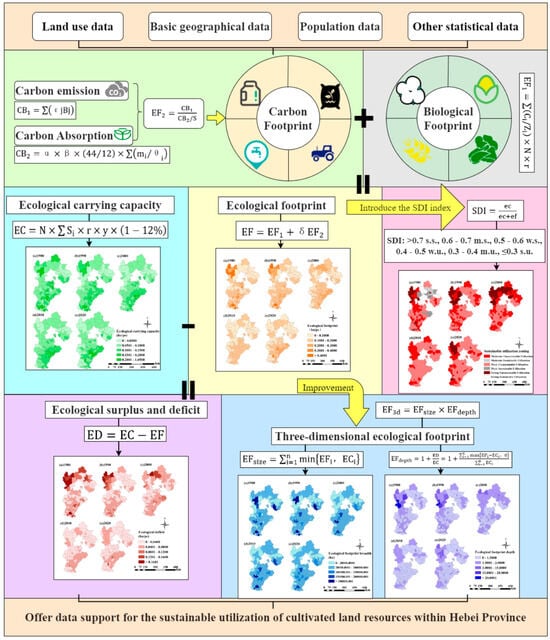
Figure 1.
Research framework diagram.
2. Materials and Methods
2.1. Study Area
Hebei Province is located on the North China Plain, featuring a terrain that slopes from the northwest to the southeast, with a complex and diverse landscape (Figure 2). In 2020, Hebei Province had a cropland area of 6.01 × 104 km2, representing 48.44% of its land area. Hebei Province is a key grain-producing region in China, with abundant cropland resources that support national and regional food security. At the same time, Hebei Province is an ecological conservation area for the Beijing-Tianjin-Hebei region.
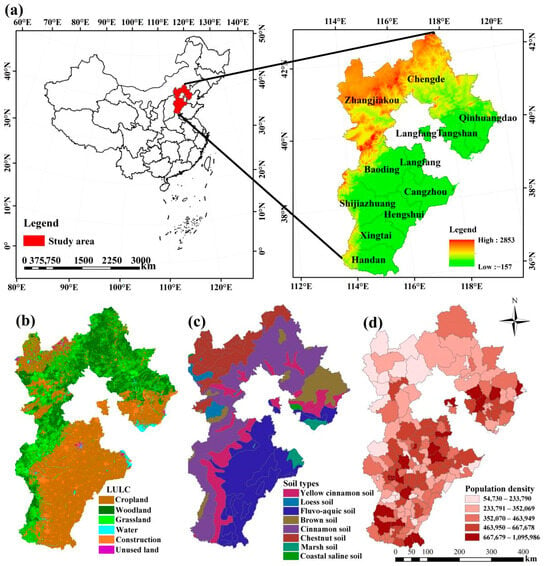
Figure 2.
Location of Hebei Province (a), land cover types in 2020 (b), soil type (c), and population density in 2020 (d).
2.2. Data Sources
The land use data used were sourced from the China Multi-Temporal Land Use Remote Sensing Monitoring Data set (CNLUCC). The data concerning agricultural pesticide usage, fertilizer application, total agricultural machinery power, crop yields and area, and irrigation area were primarily derived from the “Hebei Rural Statistical Yearbook” (1980–2020). These data were based on the administrative divisions of Hebei as of 2020, with municipalities consolidated into 132 county-level administrative evaluation units.
2.3. Methods
2.3.1. Cropland Carbon Footprint Calculation
The carbon footprint is the equivalent cropland area that is calculated based on the ecological damage caused by by-products generated during agricultural management inputs, expressed as the proportion of cropland carbon emissions relative to carbon sequestration capacity per unit area. Cropland carbon emissions are those caused directly or indirectly by cropland utilization. Cropland carbon absorption refers to the process where crops absorb and sequester greenhouse gases from the atmosphere. The use of chemical fertilizers and pesticides significantly impacts the ecological environment. Agricultural machinery use affects carbon emissions, and irrigation is a crucial component of agricultural production [44]. Therefore, the carbon footprint account in this study includes four types of agricultural inputs and management: chemical fertilizers, pesticides, agricultural machinery, and irrigation.
where EF2 is the carbon footprint generated by ecological destruction behavior; CB1 represents carbon emissions; CB2 represents carbon absorption; and S is the cropland area.
The formulas for cropland carbon emissions and cropland carbon sequestration are as follows:
where j represents agricultural activities, including the use of fertilizers, pesticides, irrigation, and mechanical cultivation, that contribute to carbon emissions. εj and Bj represent the emission coefficient and input quantity of the j-th type of activity, respectively [44]; α and β represent the correction factor (0.05) and transformation factor (0.45) for biomass and carbon sequestration [45]; the transformation factor from carbon and carbon dioxide is 44/12; and and represent the economic yield and coefficient for the ith type of crop, respectively [46].
2.3.2. Ecological Footprint (EF)
EF refers to the regional area that can accommodate the waste generated by cropland production and has biological productivity. Integrating the carbon footprint into EF calculations can comprehensively analyze negative environmental impacts from cropland use, making the calculation results closer to the real cropland ecological footprint. Hebei Province, a major grain and cotton producer in China, has a high proportion of wheat, corn, and cotton. Recently, the proportion of vegetable planting has gradually increased due to rising demand [43]. Therefore, this study’s biological resource footprint account includes four main crops in Hebei Province: wheat, maize, cotton, and vegetables.
where EF1 represents the cropland bio-capacity footprint; represents the per capita supply of the i-th crop; is the national average yield for the i-th cereal crop; N is population; and r is the cropland balance factor [44].
This study integrates the bio-resource footprint and carbon footprint in calculating cropland’s EF, enhancing the comprehensiveness of the findings.
To avoid the problem of duplicate calculation caused by directly summing EF1 and EF2, a balancing factor δ is introduced to adjust the accounting results, with its value depending on the research area. Based on existing studies [47], this research assigns a value of 0.5 to maximize the rational use of regional cropland resources.
2.3.3. Ecological Profit and Loss of Cropland (ED)
Based on EF, the ecological carrying capacity (EC) and two-dimensional EF are further introduced. EC refers to the agricultural land ecosystem’s carrying capacity [48,49]:
where EC represents the ecological carrying capacity; represents the per capita area for the i-th crop; and y is the yield factor. For more accurate results, we corrected the proportion of Hebei Province’s average cropland production capacity to the national average. This correction of (1–12%) was made based on the biodiversity protection area, as recommended in the World Commission on Environment and Development report.
The difference between the cropland ecological carrying capacity and ecological footprint is known as the ecological deficit or ecological surplus.
where ED is the surplus or deficit in cropland ecology. When EC > EF, which means ED > 0, the study region exhibits a cropland ecological surplus. Conversely, when EC < EF (i.e., ED < 0), the study region exhibits a cropland ecological deficit.
2.3.4. Three-Dimensional Ecological Footprint (EF3d)
The EF3d model clarifies the extent and intensity in cropland use. The two-dimensional EF solely reflects the surplus or deficit status of cropland. To facilitate a more comprehensive analysis, two additional indicators—footprint depth and footprint breadth—were incorporated into the existing two-dimensional model. This extension transforms the EF model to a three-dimensional framework suitable for time series analysis, thereby elucidating how socio-economic development influences the occupation of both cropland stock and flow [32]. Cropland flow is the quantity of resources generated over a specific period, a nodal value. Cropland stock, on the other hand, refers to the total amount of resources at a certain time node, an accumulative value.
- (1)
- Ecological footprint breadth ()
The cropland represents the extent of human occupation of cropland resources (hm2). It indicates the intensity and range of land resource use over a certain period, highlighting the finiteness of land resources. If the cropland EF is lower than the ecological productive cropland area provided by the study area, there is an ecological surplus, a surplus of resource flow. In this context, represents the EF of the i-th crop (EFi). When the cropland resource flow is fully occupied, that is, an ecological deficit, represents the cropland EC (ECi).
- (2)
- Ecological footprint depth ()
Given a shortage of cropland resources, when the ecological productivity of cropland is less than the of cropland, it is necessary to introduce a dimensionless index (dimensionless) to characterize the extent of human occupation of the stock of cropland resources. If the cropland area is too large, it indicates that the long-term sustainability of cropland resources is threatened. is defined as the proportion of the ED to the total area of ecologically productive cropland available. It indicates how many years are required to reproduce the cropland resources consumed by humans in one year.
When there is an ecological surplus, the flow of resources from cropland is able to meet people’s needs (0 < < 1); however, when there is an ecological deficit ( > 1), it is necessary to overdraw and utilize the stock of cropland resources.
- (3)
- Three-dimensional ecological footprint ()
The concept of describes the balance between cropland and the flow and stock of cropland resources, representing the comprehensive utilization of cropland resources by human beings.
2.3.5. Zoning for Sustainable Utilization of Cropland
To intuitively analyze the sustainable development of cropland, the sustainable cropland use index (SDI) is introduced to explore intergenerational equity in the use of cropland resources, formulated as:
where SDI represents the sustainable cropland use index; ef represents the per capita EF; and ec represents the per capita EC. SDI near 1 indicates higher sustainability of cropland use, while SDI near 0 indicates lower sustainability. SDI = 0.5 indicates a balance between cropland EF and EC, which marks the critical threshold for cropland sustainability. Based on existing research [38,50], sustainable cropland use is divided into 6 types, ranging from strongly unsustainable to strongly sustainable. Values of 0.7 < SDI, 0.6 < SDI ≤ 0.7, and 0.5 < SDI ≤ 0.6 correspond to strong (SS), moderate (MS), and weak sustainable utilization (WS), respectively. Values of 0.4 < SDI ≤ 0.5, 0.3 < SDI ≤ 0.4, and SDI ≤ 0.3 correspond to weak (WU), moderate (MU), and strong (SU) unsustainable use, respectively. The lower the sustainable utilization index, the greater the unsustainability of cropland resources.
3. Results
3.1. Evolution of Spatiotemporal Patterns of Carbon Emissions and Absorption
Cropland carbon emission refers to the adverse effects of cropland utilization on ecosystems, while cropland carbon absorption reflects carbon uptake by crops via photosynthesis, indicating the positive impact of cropland utilization on the ecosystem. When cropland carbon absorption exceeds cropland carbon emissions, the cropland is a carbon sink; otherwise, it is a carbon source.
3.1.1. Time Series Analysis
- (1)
- Cropland carbon emissions
The total cropland carbon emissions in Hebei Province rose from 219 × 104 tons in 1980 to 429 × 104 tons in 2020, representing a 95.9% rise. The average annual compound growth was 1.58% (Figure 3). Overall carbon emissions resulting from fertilizers and agricultural irrigation have risen, with annual average compound growth rates of 3.33% and 0.51%, respectively. Conversely, the carbon emissions stemming from pesticides and agricultural machinery have decreased, with annual average compound growth rates of −1.00% and −0.04%, respectively. The decline in emissions is due to the fuel efficiency of modern machinery, optimized practices like precision farming, and the positive impact of large-scale operations on reducing emissions both in the short and long term [51]. The Hebei Provincial Department of Ecology and Environment reported in its “2020 Work Plan” that the phase-out of 12,000 units of low-emission-standard agricultural machinery resulted in significant emission reductions. From 1980 to 2014, the total carbon emissions from cropland fluctuated upwards, mainly due to the increased use of agricultural inputs like pesticides and fertilizers. From 2014 to 2020, carbon emissions declined, which was attributed to the reduction in land area used for agriculture in Hebei Province, the promotion of ecological environment protection, and the development of eco-friendly agriculture. Prior to 1984, agricultural irrigation contributed the highest proportion of carbon emissions, while after 1984, fertilizers became the main contributor. Overall, carbon emissions from fertilizers initially increased and then decreased, surpassing 50% in 1990 and reaching a maximum proportion of 64% in 2012. In 2020, carbon emissions caused by fertilizers, pesticides, agricultural machinery, and agricultural irrigation accounted for 61.32%, 6.07%, 4.29%, and 29.42% of the total carbon emissions, respectively. It is evident that scientifically controlling the application of fertilizers is crucial for ensuring cropland ecological safety in Hebei Province.
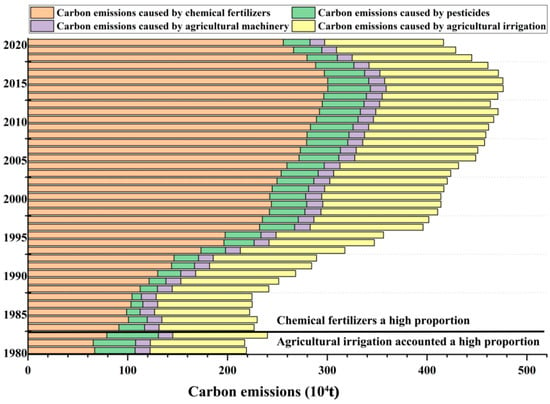
Figure 3.
Carbon emissions from cropland in Hebei Province from 1980 to 2020.
- (2)
- Carbon absorption in cropland
From a temporal change perspective (Figure 4), the cropland in Hebei Province absorbed a total of 3751 × 104 tons of carbon in 1980 and 17,373 × 104 tons in 2020, demonstrating a compound annual increase of 3.81%. Given the high ratio of cropland area in Hebei Province, as well as long crop growing periods and high yields, the carbon absorption of cropland is relatively high. Between 1980 and 2020, the carbon absorption of wheat, corn, and vegetables experienced significant increases, exhibiting a compound annual increase of 3.34%, 2.77%, and 5.64%, respectively. The carbon absorption of cotton showed a negative growth, exhibiting a compound annual increase of −0.33%. Regarding carbon absorption by different crop type, corn dominated before 1983, while wheat led from 1984 to 1992. From 1993 to 2020, vegetables became the primary contributor, exceeding 50% of the overall carbon sequestration from 1999 to 2009. In 2020, wheat, corn, cotton, and vegetables accounted for 21%, 29%, 1%, and 49% of the total carbon absorption, respectively. Taking into account the planting area of various crops, the carbon absorption capacities of the four crops were in the following descending order: vegetables > wheat > corn > cotton. Although the carbon absorption of crops is related to the size of the planting area, vegetables produce higher carbon absorption compared to wheat and corn, despite having a much smaller planting area. With the increase in population demand, the area dedicated to vegetables will continue to maintain a high level, which will further contribute to achieving localized dual carbon goals.
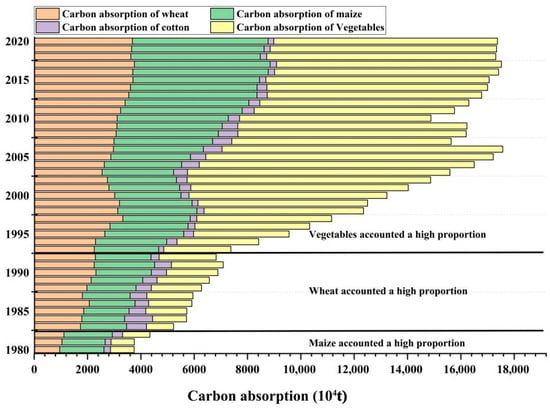
Figure 4.
The carbon absorption by various crops in Hebei Province from 1980 to 2020.
- (3)
- Analysis of carbon emission and absorption intensity
The intensity is defined as carbon emissions and absorption per unit area of crop planting (t CO2 eq/hm2). From the overall perspective of Hebei Province (Figure 5), significant changes in cropland area from 1980 to 2020 led to significant changes in carbon emission/absorption intensity. The carbon emission intensity generally exhibited a variable increasing trend, achieving a compound annual increase of 1.83% from 1980 to 2020, peaking in 2014 at 0.728 t CO2 eq/hm2, followed by a fluctuating decline. A significant increase occurred in 2018, with a growth rate of 2.08%. The carbon absorption intensity generally exhibited a variable growth trend, achieving a compound annual increase of 4.36% from 1980 to 2020. After reaching its highest value in 2004 (27.822 t CO2 eq/hm2), it fluctuated downward and began to show an increasing trend after 2010. From 1980 to 2020, the carbon absorption intensity of cropland in Hebei Province was significantly higher than its carbon emission intensity.
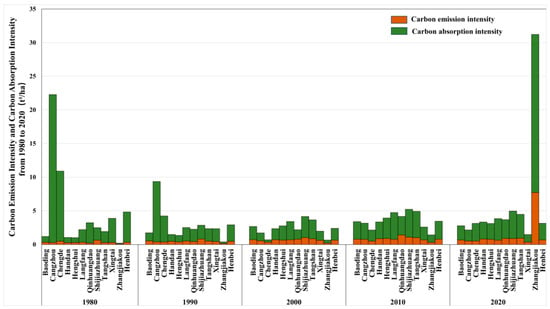
Figure 5.
Carbon emissions intensity and carbon absorption intensity across various cities in Hebei Province from 1980 to 2020.
Based on Figure 5, and in conjunction with Figure 3 and Figure 4, it is evident that carbon absorption significantly exceeds carbon emissions. This indicates that the ecological system of cropland in Hebei Province is overall in a carbon surplus state, meaning that the cropland in Hebei Province acts as a carbon sink. Regionally, the amount of carbon absorption exceeds carbon emissions in each region, although annual trends exhibit significant spatial variability. Additionally, the intensity varies greatly across different years. In 1980, marked regional variations in carbon emission intensity were evident, with Cangzhou and Chengde exhibiting notably higher levels. By 1990, however, these levels had declined substantially. In 2020, Zhangjiakou witnessed a significant increase in the two intensity indicators. This was mainly due to the expansion of vegetable planting areas and the land reclamation, both of which contributed to substantial improvements in fertilization and irrigation levels. Specifically, regarding these two indicators, from 1980 to 2020, six prefecture-level cities (Baoding, Handan, Hengshui, Langfang, Shijiazhuang, and Tangshan) exhibited a trend of first increasing and then decreasing. This trend was primarily driven by population-induced food production pressures, which expanded planting areas and increased agricultural inputs. However, cropland carbon emission stress was alleviated by recent policy interventions, such as the implementation of “fertilizer reduction and efficiency improvement” measures. In Qinhuangdao, Xingtai, and Cangzhou, carbon absorption intensity initially decreased and later increased, whereas emission intensity first increased and then decreased. These changes were driven by land deterioration and high carbon emissions from agriculture prior to 2000 and subsequent ecological improvements through the Three-North Shelter Forest Program after 2000, which increased carbon absorption.
3.1.2. Spatial Variability Analysis
- (1)
- Carbon Emissions
Utilizing the GIS natural breakpoint method, both the total carbon emissions and emission intensity from croplands across various counties in Hebei province were categorized into five groups, and their spatial disparities and patterns of variation were investigated (Figure 6). The carbon emissions at the county scale in Hebei province exhibit a spatial distribution characterized by higher values in the eastern and central parts and lower values in the northwest. Elevated emission levels are predominantly found in eastern counties such as Laoting and Changli, as well as in Xinji City and the jurisdiction of Hengshui City in the central part of the province. Middle-value areas are observed in cities such as Qinhuangdao and counties like Lulong in the east, as well as in counties such as Linxi and Wuqiao in the eastern and central parts. Regions with minimal regions are concentrated in the higher-altitude mountainous regions in the northwest, such as Kangbao and Zhangbei counties. In terms of spatial change patterns, the areas where the total carbon emissions decreased significantly from 1980 to 2020 are mainly distributed in Shijiazhuang and its surrounding areas, but the carbon emission intensity in this area remains relatively high. The reason is that during the rapid urbanization of Shijiazhuang, a significant amount of cropland was taken over, leading to a reduction in the area for crop planting, which resulted in inconsistent regional variations in total carbon emissions and carbon emission intensity. These regions exhibited an elevated carbon emission intensity. These regions should be identified as key areas for reducing carbon emissions from cropland. In the future agricultural production process, policymakers should provide policies supporting the development of eco-agriculture, especially in counties within the central and eastern regions where carbon emissions are relatively high.
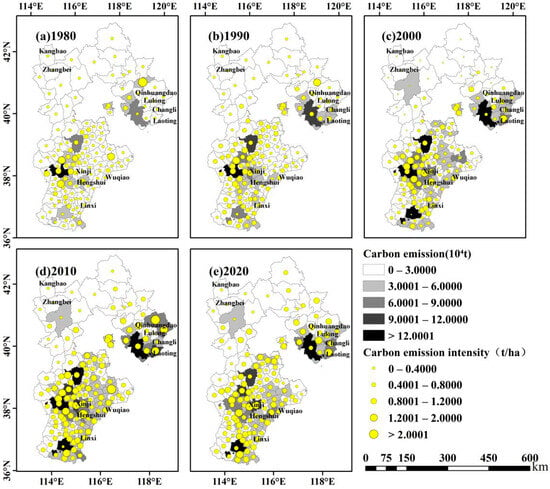
Figure 6.
The spatial distribution of total carbon emissions and carbon emission intensity of cropland in Hebei Province.
- (2)
- Carbon absorption
Both carbon sequestration and its intensity in Hebei Province exhibited higher values in the eastern and central parts, while lower values were observed in the western and northwestern parts (Figure 7). High-value regions were concentrated near Beijing and Tianjin, as well as in the eastern plain areas such as the urban areas of Tangshan, Zunhua, and Baoding. Regions with minimal values were predominantly located in the Taihang-Yanshan Mountains and the Bashang Plateau region. This distribution pattern was related to the area of crop planting. Due to the development of plateau characteristic ecological agriculture and the increasing crop plantings in plain areas, the total carbon absorption and carbon absorption intensity in Hebei’s counties significantly increased in the Jibei Bashang Plateau and plain areas from 1980 to 2020. Both carbon sequestration and its intensity in areas such as Nangong City and Hengshui City in central Hebei Province exhibited a “decrease–increase” trend. This pattern can be attributed to the optimization of agricultural ecological management and the adjustment of crop structures aimed at reducing excessive groundwater extraction.
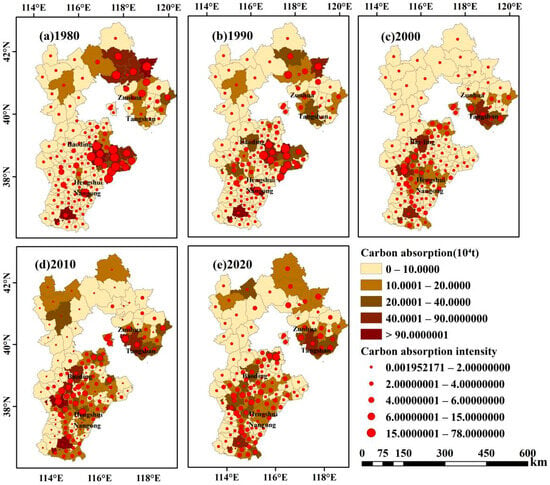
Figure 7.
The spatial distribution of carbon absorption and its intensity.
3.2. Per Capita Ecological Footprint (EF) and Ecological Balance (Surplus/Deficit)
3.2.1. Changes in Hebei Province and Different Prefecture-Level Cities
To more accurately characterize the actual occupation of cropland ecology in Hebei Province, the results are expressed in per capita values. Since 1980, the per capita cropland EF in Hebei Province and its various cities has exceeded the per capita ecological carrying capacity (EC), indicating a per capita ecological deficit. These findings show that human pressure on cropland has surpassed the EC, and the ecological environmental pressure on cropland has exceeded its load (Figure 8). From 1980 to 2020, the per capita cropland EF decreased generally, from 0.17 hm2 per person in 1980 to 0.11 hm2 per person in 2020. The most rapid decline occurred between 1980 and 1985, and from 1985 to 2020, the trend fluctuated downward. The per capita cropland EC remained relatively stable overall, with the trend in each year being similar to those of the per capita cropland EF. Although the gap between per capita EF and EC has gradually narrowed, indicating a reduction in cropland ecological deficit across Hebei Province, cropland resource conditions remain “in short supply”. The ecological deficit phenomenon continues to persist.
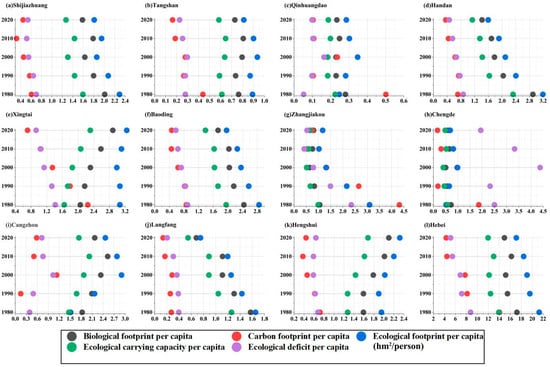
Figure 8.
The per capita biological footprint, carbon footprint, ecological footprint (EF), ecological carrying capacity (EC), and ecological deficit in Hebei Province.
In terms of region, the annual changes in indicators in Shijiazhuang, Baoding, Handan, and Langfang exhibited a consistent decreasing trend. Handan and Langfang experienced the largest decrease in 2020, with all indicators in Handan falling below 2 and all indicators in Langfang dropping below 0.5. On the other hand, Hengshui showed a significant increasing trend in all indicators, particularly in 2020. Hebei Province, Tangshan, Xingtai, and Qinhuangdao had high per capita carbon footprints in 1980; however, their indicator changes in other years were relatively consistent. Tangshan showed a significant decreasing trend in all indicators, Qinhuangdao had relatively low values, and Xingtai showed a gradual increase. On the other hand, Cangzhou, Zhangjiakou, and Chengde experienced significant fluctuations in their annual indicators. Cangzhou had a trend of increasing followed by a slow decrease, while Zhangjiakou had high indicators in 1980 but saw a decrease to below 2 after 1990. Chengde’s carbon footprint exhibited an unstable trend of “sharp drop–slow increase–decline,” decreasing from 2 in 1980 to below 0.5 in 1990, then rising to 1 in 2000, but dropping below 0.5 again from 2010 to 2020. This indicated an overall reduction in carbon emissions.
3.2.2. Changes in the County-Level Spatial Pattern
- (1)
- The per capita EF and ecological deficit
Between 1980 and 2020, variations in the per capita EF and ecological carrying capacity were observed across counties, but they generally showed a downward trend (Figure 9). This trend was caused by the decrease in crop planting area due to the decrease in cropland area. For the per capita EF, the most significant decrease occurred in the central and northern counties of Zhangjiakou City, followed by the urban areas of Handan City and Wei County. However, the per capita EF in eastern Hebei Province exhibited a trend of “increase-decrease-increase”, as observed in locations such as Huanghua City, Haixing County, Botou City, and Jing and Gucheng County. The per capita EC within urban areas of Handan City, Zhangjiakou City, and counties such as Weichang, Ci, and Wei showed a downward trend. This was attributed to the decrease in cropland supply in these areas, causing a reduction in the cropland per capita. With rising cropland demand, the ecological carrying capacity of cropland continued to decrease. Wuqiao County, Botou City, Shenzhou City, and Jing County in the eastern part of Hebei Province showed a declining trend.
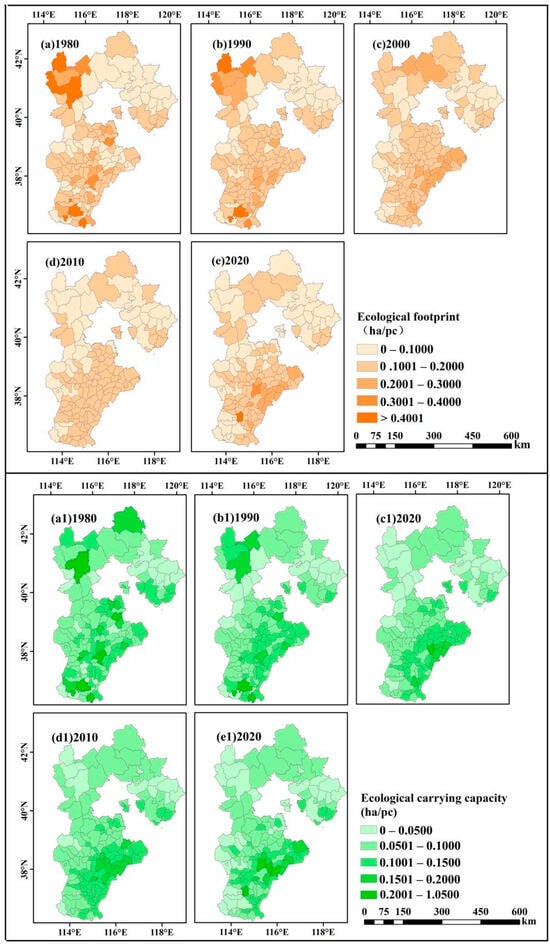
Figure 9.
The per capita EF and EC of cropland in Hebei Province.
- (2)
- Spatial characteristics of the per capita cropland ecological deficit
The global Moran’s I index was selected to conduct spatial autocorrelation of per capita cropland ecological deficit. Spatial autocorrelation evaluates the relationship of a variable across distinct spatial units, serving as a key indicator to assess whether an element’s attribute values are strongly associated with those of its neighboring spaces. The I index varies between −1 and 1. A value above 0 signifies positive spatial autocorrelation in the per capita cropland ecological deficit, indicating spatial clustering. Conversely, a value below 0 denotes negative spatial autocorrelation, indicating spatial dispersion [52].
Table 1 indicates that Moran’s I index overall was positive, with all p values being less than 0.01, thus passing the significance test with a confidence level exceeding 99%. This suggests a notable clustering feature in the per capita ecological deficit, demonstrating a strong positive spatial association. A clustered phenomenon (high-high or low-low) was exhibited, with high-value counties bordering other high-value counties and low-value counties neighboring other low-value counties. Overall, the spatial clustering degree in each year was relatively stable, with a small variance in change. The overall spatial pattern of the per capita ecological deficit of cropland in Hebei Province did not change significantly. The global Moran’s I index showed an increasing trend, indicating a strengthening trend of clustering of the per capita ecological deficit of cropland in Hebei Province. There was also a narrowing trend in spatial differences between adjacent counties, which was related to the decrease in cropland area caused by economic development and regional population aggregation.

Table 1.
Global Moran’s I index for the per capita cropland ecological deficit.
In terms of spatial pattern changes (Figure 10), between 1980 and 2020, the ecological footprint of cropland in various counties of Hebei Province exceeded the ecological carrying capacity, indicating an ecological deficit of cropland. A high pattern was observed in the northwest and southeast, with an overall decrease in the degree of ecological deficit. Urban areas in Handan and Zhangjiakou, as well as the counties of Kangbao, Shangyi, Fengning, Weichang, Ci, and Wei, exhibited a downward trend, while Huanghua City, Haixing County, Nanpi County, and Shenzhou City showed a pattern of fluctuation characterized by “increases followed by decreases and then increases”. Overall, the distribution of the per capita EF and ecological deficit of cropland across the counties was consistent, with both concentrated in the high-value areas of northwestern Hebei Province. These areas belong to ecologically fragile areas, and the impact of cropland utilization on ecological security is significant. Cropland exploitation and use have imposed significant pressure on the ecological conditions; therefore, subsequent attention should focus on the ecological pressures of cropland in this area.
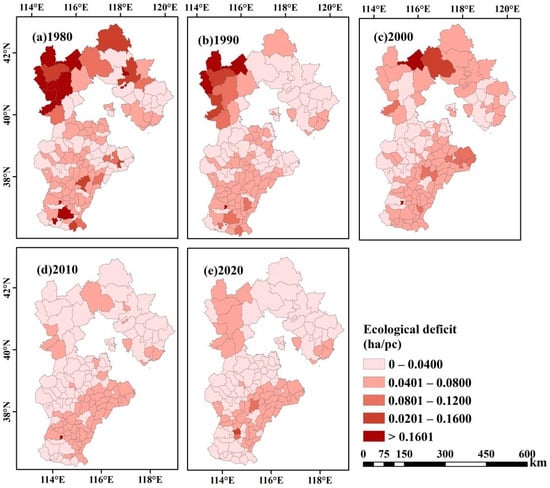
Figure 10.
The per capita cropland ecological deficit in Hebei Province.
3.3. EF3d of Cropland
According to the aforementioned research, cropland in Hebei Province is facing an ecological deficit, and resources utilization has reached its limit. Nevertheless, the two-dimensional ecological carrying capacity (EC) merely indicates its ecological security status. It is also necessary to clarify the consumption of cropland flow and stock resources in Hebei Province, that is, the breadth of cropland resources () and the depth of cropland resources (), and to then analyze cropland (). Areas with high cropland endowment had large cropland flow and consumed a small amount of cropland stock, such as Shijiazhuang and Baoding. Conversely, areas with insufficient cropland resources mainly made up for the gap by occupying stock, such as Zhangjiakou and Chengde in the ecologically fragile northwest.
3.3.1. Temporal Pattern of Variation
All of Hebei Province’s cropland was in an ecological deficit, with the flow of cropland resources fully utilized, and its was equal to its ecological carrying capacity. Hebei Province showed a pattern of “sudden decrease-slow increase-sudden decrease”, with indicating an overall downward trend (Figure 11). However, human activities on cropland are currently at a relatively high level, exceeding its ecological carrying capacity. EFdepth represents the cumulative demand of humans for cropland beyond its ecological carrying capacity; a higher value indicates increased consumption of cropland stock and heightened stress on cropland ecosystem. From 1980 to 2020, the trend of cropland EFdepth exhibited an “increase-decrease” pattern, where all values exceeded 1. This indicates that the flow of cropland was insufficient to meet agricultural development needs, requiring the annual consumption of cropland stock to fulfill societal demands. Between 1980 and 1997, the utilization rate of cropland stock consistently exceeded 50%. In 1982, the utilization rate peaked at 73%, with cropland EFdepth reaching a value of 1.73. This means that the region needed 1.73 times the area of cropland to meet the consumption demands in Hebei Province that year, highlighting a significant ecological deficit in cropland. Although the cropland EFdepth decreased from 1980 to 2020, it remained at 1.4 in 2020, with the utilization rate of cropland stock still reaching 40%. In particular, from 2015 to 2020, there was an upward trend in cropland EFdepth, indicating that the current situation of excessive occupation of cropland stock is still severe, and the pressure on cropland ecological security is significant. The decline in cropland EF3d in Hebei Province is clearly evident, particularly with the most significant decrease occurring between 1995 and 2000.
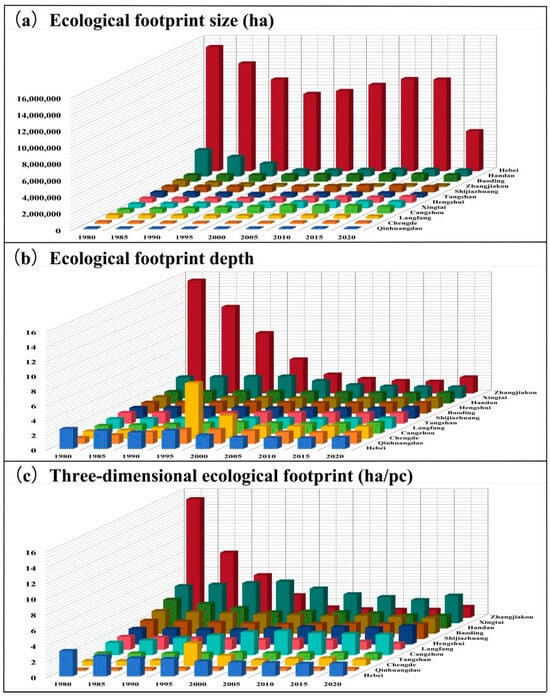
Figure 11.
The cropland EFsize, EFdepth, and EF3d of Hebei Province and its prefecture-level cities.
Regarding regional distribution, the change in cropland EFsize in other areas was relatively minor compared to Handan City. From 1980 to 2020, it experienced a high cropland EFsize that underwent a significant reduction. The cropland EFsize of Zhangjiakou City exhibited a pronounced annual decline. Shijiazhuang City and Baoding City exhibited relatively high EFsize values, with stable changes. Meanwhile, Cangzhou City demonstrated a clear annual increasing trend. The EFsize values of other areas were relatively small and experienced stable changes. Unlike EFsize, the regional variation in EFdepth is more pronounced. The cropland EFdepth in Zhangjiakou City and Chengde City was relatively high, indicating a significant consumption of cropland resources in these areas, which places greater emphasis on the cropland ecosystem. However, due to the promotion of ecological protection policies and adjustments in the land use structure, Zhangjiakou City experienced a significant decrease in cropland EFdepth from 1980 to 2020. In areas such as Xingtai, Baoding, Cangzhou, Tangshan, and Chengde, the cropland EFdepth initially increased and then decreased. Notably, the cropland EFdepth in Chengde City experienced a significant increase in 1995. The regional variations in cropland EF3d changes were more pronounced, with Xingtai, Handan, Baoding, Qinhuangdao, and Langfang exhibiting an overall decreasing trend. In contrast, Xingtai consistently maintained a relatively high level. The cropland EF3d in Zhangjiakou underwent significant changes, peaking in 1990 before experiencing a decline, whereas Shijiazhuang remained relatively stable. Unlike other areas, the cropland EF3d of Hengshui has been experiencing a slow growth trend, as its EFdepth has consistently remained at a relatively high level. Substantial variability exists in the EFsize, EFdepth, and EF3d changes across the prefecture-level cities of Hebei Province. Consequently, tailored measures should be implemented for regional cropland ecological security management in the future.
3.3.2. Spatial Pattern of Variation
- (1)
- Spatial distribution characteristics of different counties
It is evident that the spatiotemporal patterns of EFsize, EFdepth, and EF3d for cropland have evolved over time (Figure 12). First, the changes in cropland EFsize were clearly discernible. From 1980 to 1990, high-value and low-value areas were distributed sporadically throughout the region, while areas of medium value exhibited a broader distribution. Between 2000 and 2020, high-value areas began to concentrate in the eastern and southern parts, while regions with minimal values were mainly distributed near the Taihang Mountains in the western part and the Yan Mountains in the northern part of the province. In 2020, regions with elevated values were predominantly clustered in the southern area of Hebei Province. Second, the changes in cropland EFdepth reflected distinct characteristics. From 1980 to 1990, the middle-value regions were predominantly clustered in the northwestern part. Between 2000 and 2010, the extent of high-value regions significantly decreased; in particular, there was a notable reduction in county-level cropland EFdepth by 2010. By 2020, high-value areas exhibited a trend of aggregation in the northwest. The cropland EFdepth of the Bashang Plateau in the north was always relatively large, primarily due to the high ecological footprint of cropland in these counties, resulting in greater consumption of cropland stocks. Lastly, the changes in the cropland EF3d demonstrated unique patterns. From 1980 to 2000, the middle-value regions were highly clustered in the southern and northwestern parts. Between 2010 and 2020, they mainly concentrated in the southeast, with minor spatial pattern changes during this period.
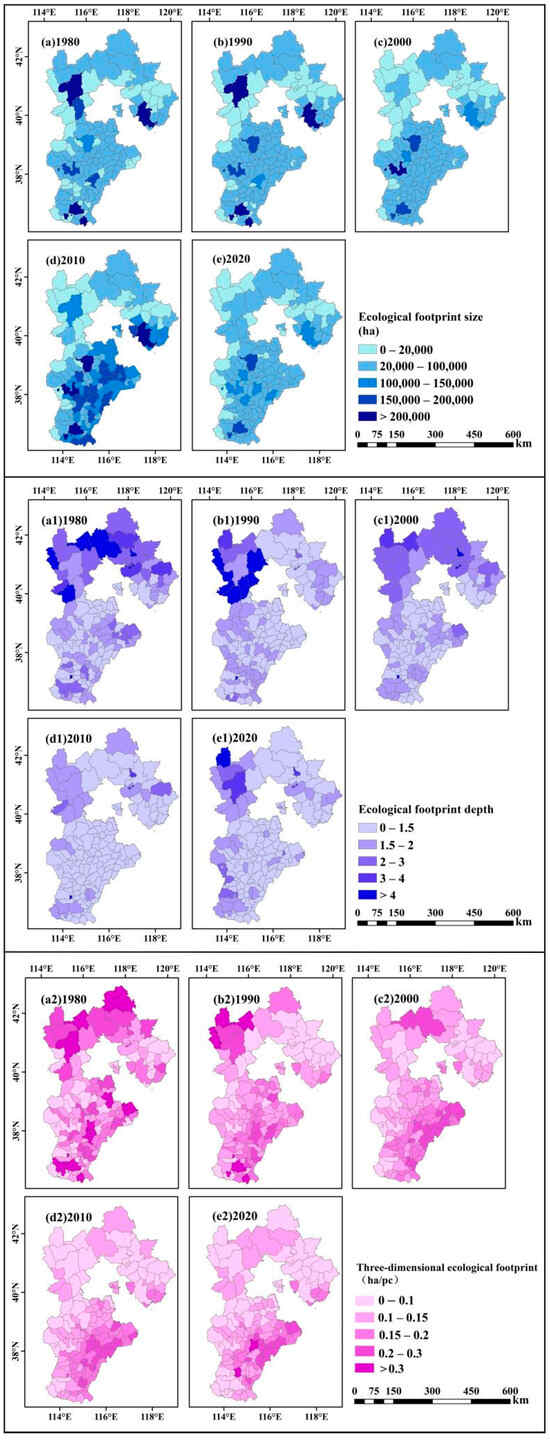
Figure 12.
The distribution of cropland EFsize, EFdepth, and EF3d in Hebei Province.
Regarding spatial distribution, cropland EFsize showed a “western low, eastern high” distribution pattern, whereas cropland EFdepth displayed the opposite trend. From 1980 to 2020, the distribution of high-value cropland EFsize areas demonstrated a pattern of “initial dispersion followed by concentration,” with higher-value regions increasingly concentrated in the east and south, particularly in counties such as Wuqiao, Jing, and Wuyi. The trend of high-value areas concentrating in the western region persists, yet the scope of this concentration has become more confined. As the cropland EFdepth was greater than 1 for all, it suggested a growing imbalance in cropland supply and demand, thereby increasing stress on cropland ecological security. From 1980 to 2020, the distribution of high-value cropland EF3d areas showed an initial aggregation in the northwest, followed by a concentration in the southeast. Overall, however, the cropland EF3d exhibited a decreasing trend.
- (2)
- The per capita cropland EFDepth spatial transfer process
EFDepth can indicate potential threats to the long-term sustainability of cropland resources. Utilizing the center-standard deviation ellipse method [53], the spatio-temporal transfer trajectory of the per capita cropland EFdepth in Hebei Province was analyzed, enhancing the comparability of ecological environmental issues faced by cropland resources across different periods and regions. The spatial evolution process of the per capita cropland EFdepth in Hebei Province is evident (Figure 13). From 1980 to 1985, the centroid shifted 14.7 km to the southeast. This was followed by a movement of 18.6 km from 1985 to 1990, 49.4 km to the northeast from 1990 to 1995, 35.7 km to the southwest from 1995 to 2000, and an additional 14.6 km to the southwest from 2000 to 2005. The offset distance has significantly decreased since 2005, indicating that the initial changes in the per capita cropland EFdepth were more pronounced than the subsequent ones. Between 1990 and 2000, both the transfer distance and the major and minor axes of the standard ellipse for the center shift decreased significantly, indicating that counties with higher concentrations of the per capita cropland EFdepth in the eastern part of Hebei Province were more prominent. This trend can primarily be attributed to accelerated economic development, dense population concentrations, and urban expansion encroaching upon cropland, leading to a substantial reduction in cropland. Overall, from 2005 to 2020, the changes in the transfer distance of the center and the major and minor axes of the standard deviation ellipse were not significant, indicating that the per capita cropland EFdepth in Hebei Province has maintained relatively stable spatial characteristics. From 1980 to 2000, the centers of the per capita cropland EFdepth were in Yi County, Baoding City, Baoding City, Rongcheng County, and Anxin County. However, from 2005 to 2020, the focus shifted to Gaoyang County, which has now become a key area for cropland ecological security regulation.
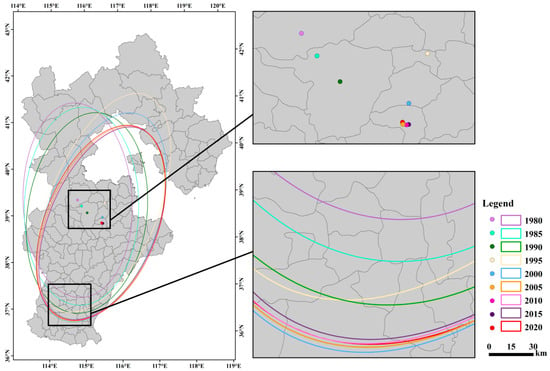
Figure 13.
Standard-deviational ellipse and centroid shift trajectory of the per capita cropland EFdepth.
3.4. Zoning for Sustainable Utilization of Cropland
The study of the ecological footprint reflects the ecological deficit of cropland in Hebei Province. To visually represent the sustainable use levels of cropland across various counties in Hebei Province, a sustainable use index was employed to categorize the sustainable use status of cropland in the region. From the perspective of provincial regions, cropland has consistently been in an unsustainable state from 1980 to 2020; however, there has been a reduction in its unsustainable capacity.
The statistics show the number of counties in Hebei Province and various prefecture-level cities with different types of sustainable utilization zoning of cropland (Figure 14). In 1980, sustainable utilization was observed in several areas, with strongly sustainable utilization (SS) concentrated in Zhangjiakou, Chengde, and Qinhuangdao, moderately sustainable utilization (MS) in Chengde, and weakly sustainable utilization (WS) present in Zhangjiakou, Chengde, and Cangzhou. From 1990 to 2020, Hebei Province and its prefecture-level cities were all designated as unsustainable zones for cropland. In 1990, aside from Zhangjiakou, which had a high concentration of strongly unsustainable utilization (SU) zones, the other areas were primarily categorized as weakly unsustainable utilization (WU) and moderately unsustainable utilization (MU). In 2000, Zhangjiakou, Chengde, and Qinhuangdao had no WU distribution. In terms of regional differences, except for Zhangjiakou and Chengde, other areas were mainly WU and MU. Analyzing the trajectory of changes in WU quantity revealed a trend of an increase followed by a decrease in Shijiazhuang, Xingtai, Baoding, Zhangjiakou, and Hebei Province. Tangshan, Handan, and Hengshui mainly exhibited an increasing trend, while Qinhuangdao, Chengde, Cangzhou, and Langfang showed more drastic changes between different years. When examining the trajectory of MU quantity changes, Hebei Province, Qinhuangdao, Xingtai, Baoding, Zhangjiakou, and Cangzhou displayed a pattern of “increase-decrease-increase”, emphasizing the necessity for special attention to be paid to the upward trend of MU quantity from 2010 to 2020. Tangshan, Handan, and Chengde exhibited an initial increase then a decrease in MU quantity. Shijiazhuang demonstrated an initial decrease then an increase. Meanwhile, Hengshui’s MU zones continued to decrease. When examining the trajectory of SU quantity changes, the trend in Zhangjiakou and Chengde was exactly the opposite, with an increasing trend of SU in Zhangjiakou from 2010 to 2020. This indicates that the use of cropland in this region exerts considerable pressure on sustainable development. Overall, the trends in cropland sustainable use in these areas offer a foundation for optimizing the governance and control in cropland ecological security.
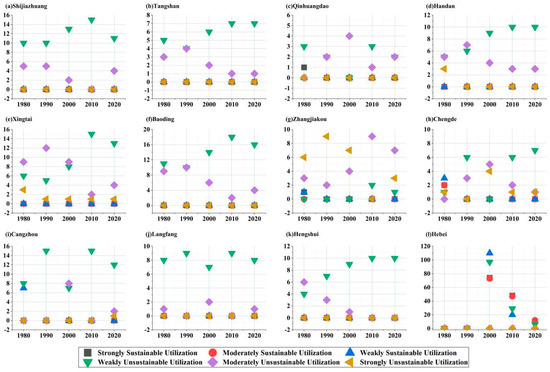
Figure 14.
The number of counties in Hebei Province and various prefecture-level cities with different types of sustainable utilization zoning of cropland.
Regarding county zoning (Figure 15), cropland in the north and east of Hebei Province was in a sustainable state in 1980, primarily characterized by MS and WS. The cropland in the northwestern and central regions predominantly exhibited an unsustainable status, with a high proportion classified as WU and MU. There were changes in the distribution from 1990 to 2020. The range of SU and MU significantly expanded from 1980 to 2000. In 1990, SU and MU counties exceeded 50% of all counties in Hebei Province. From 2000 to 2010, WU counties increased in number, reaching a total of 110 WU counties by 2010, which accounted for approximately 83% of all counties. However, from 2010 to 2020, MU and SU counties increased, while WU counties declined. By 2020, WU counties had decreased to 95, representing 73% of all counties. Conversely, MU and SU counties had increased to 28 and 8, respectively, raising their combined proportion to 27%. Although the changes in sustainable use zoning from 2010 to 2020 were not as significant as those from 1980 to 2010, the trend of increasing areas with high levels of unsustainable utilization of cropland over the past decade warrants attention. Overall, since 1990, cropland in all counties of Hebei Province has been in an unsustainable status, indicating that the conservation situation of cropland use in the region is still severe. Regions with high levels of unsustainable cropland use were predominantly concentrated in the western region. Specifically, the zones exhibiting strongly unsustainable cropland utilization with a “rise-fall-rise” pattern highlight the impact of changes in cropland management practices and policies on the sustainability of cropland use. Therefore, it is imperative to promptly implement cropland protection policies that are tailored to local conditions in the future.
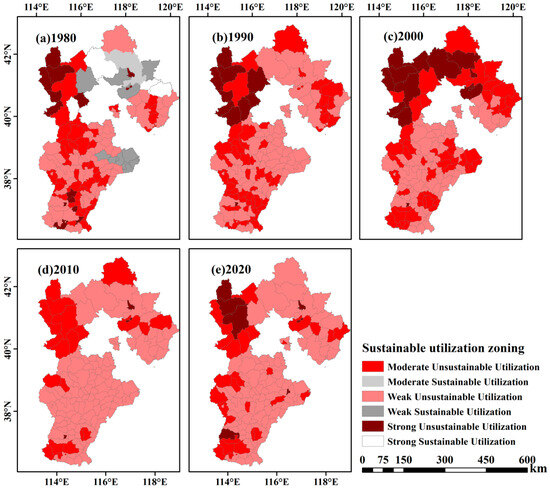
Figure 15.
Zone division for sustainable utilization of cropland in Hebei Province.
4. Discussion
4.1. Comparison with Related Research Findings
Research into the cropland ecological footprint (EF) is crucial for maintaining the structural integrity and functional stability of agricultural ecosystems, laying the groundwork for future ecological agriculture practices. It provides a foundation for addressing the scarcity of reserve cropland resources and enhancing the ecological carrying capacity in major grain-producing regions, offering regulatory strategies to mitigate these issues. The findings revealed that the per capita cropland EF in Hebei Province declined between 1980 and 2020. However, the issue of an ecological deficit in cropland remains prevalent. These findings are consistent with the conclusions of Chen et al. [54], who studied the Beijing-Tianjin-Hebei region using ecological footprint calculations for simulations and predictions. Their results indicated that the ecological footprint of this region decreased from 2000 to 2022 and was projected to decline by 16.85% under a sustainable scenario. However, by 2035, all cities in the region will still be in an unsafe state, averaging an ecological footprint of 6.210 hm2/cap, exceeding their ecological carrying capacity by more than 27 times. This study also revealed that Hebei Province has experienced a continuous ecological deficit since 1990. Therefore, examining the sustainable use of cropland through the framework of ecological footprint analysis is vital for improving both food security and ecological integrity of land. Shen et al. [22] analyzed Hebei Province between 2002 and 2016, indicating that the EFdepth was substantial during this period, leading to significant resource depletion in the region. These findings align with our study’s results, which indicated that the flow of cropland resources in Hebei Province has reached its maximum capacity. Although the overall occupancy of cropland resource stocks has been declining, the issue of excessive occupation of land resource stocks remains, with land stocks still accounting for 40% of the total in 2020. Zhang et al. [55] assessed land sustainability based on EF spatial distribution in the Beijing-Tianjin-Hebei region. Their results showed that the sustainable development capacity (ECI) in the south exceeded that in the north, consistent with our study’s results of high unsustainable development capacity in the northwest of Hebei Province. However, there are also differences. In this study, certain southern counties exhibited a significant degree of unsustainable development. This discrepancy can be attributed to Zhang et al.’s comprehensive consideration of water and land resources, whereas this study focused solely on cropland resources. The extensive cropland area and its high usage intensity in certain southern counties lead to the unsustainable exploitation of cropland resources.
From a global perspective, studies have been conducted on the EF of cropland and its sustainable use from various angles. For instance, research in the Nigerian region has demonstrated that agricultural production activities and increased yields both promote the EF of different types of agricultural land, reducing their sustainability [56]. The findings of this study are largely consistent with the results of our research. However, while the Nigerian study assessed the impact of agricultural land development on sustainable development from a macro perspective, our study considered crop types to analyze changes in carbon footprints and the sustainability of cropland. Furthermore, research on the corn belt planting area in the United States [57] aligns with our study, indicating that farmland expansion was the main factor contributing to the increase in the carbon cost of food production in that region. Unlike our study, which focuses on crop types and agricultural production activities, their research took the replacement of different types of land areas as a premise for carbon footprint accounting and proposed pursuing a sustainable development path of high yield through the conversion of agricultural land. Furthermore, research conducted in Turkey examined the premise that the ecological carrying capacity should be equal to or exceed the ecological footprint to ensure sustainable cropland use. It explored factors that mitigate ecological footprint deficits by analyzing regions with ecological carrying capacity [58]. Global research can provide valuable insights for future studies, and integrating regional realities with such research can offer diverse approaches for regional regulation of the ecological footprint of arable land.
As can be seen, despite differences in perspectives and methods, our findings are comparable to those of relevant domestic and international studies from various perspectives. By improving ecological footprint research through the lens of carbon footprint, our study expands the evaluation system for sustainable cropland use. Furthermore, many related studies often focus on relatively short time scales of 10 to 20 years, limiting a comprehensive understanding of the spatio-temporal evolution and laws governing land ecological footprints. The research addresses this gap through the integration of cropland EF3d analysis and the identification of spatial patterns of sustainable land use. Consequently, it offers direct insights for optimizing cropland use patterns and fostering ecological development.
4.2. Improving the EF3d with Carbon Footprint Enables More Accurate Evaluation of Cropland Use’s Effects on Ecosystem Security
Hebei Province, one of China’s thirteen key agricultural regions, is critical for maintaining food security in the Beijing-Tianjin-Hebei region and the nation, given its extensive cropland. Furthermore, Hebei Province acts as a vital ecological security barrier for Beijing and Tianjin. The cropland in Hebei Province thus carries the dual responsibilities of providing a sustainable food supply and maintaining ecological value. Exploring the dynamics of cropland carbon emissions and absorption can bring the ecological footprint value of cropland closer to its true value and provide a more precise assessment of the ecological impact of cropland utilization. For example, with the decrease in cropland area, although agricultural inputs have increased, the overall ecological footprint has not significantly increased due to the improvement of agricultural production efficiency or effective control of carbon emissions [59]. Regional studies have revealed that Qinhuangdao City, Zhangjiakou City, and Chengde City all exhibit a per capita carbon footprint that surpasses their per capita ecological footprint. This suggests that the rapid growth in the carbon footprint of these areas, primarily driven by rising energy consumption and carbon emissions, is directly impacting regional cropland ecological security. Therefore, analyzing the carbon footprint is essential when assessing the cropland EF.
Agricultural input management constitutes a significant proportion in Hebei Province. Integrating the carbon footprint into the cropland EF enables a more precise reflection of cropland’s ecological conditions by accounting for various inputs, including fertilizers, pesticides, irrigation, and agricultural machinery power. This study found that since 1984, fertilizers have been the main driver of increasing carbon emissions, accounting for as much as 61.32% of emissions in 2020. This indicates that the ecological security regulation of cropland should prioritize the rational use of fertilizers. It is evident that precise fertilization and scientific fertilizer management are crucial measures for reducing carbon emissions in the region, and they also offer insights and guidance for future agricultural carbon emission reduction efforts. Before 1984, agricultural irrigation was the largest contributor to carbon emissions. However, by 2020, its impact accounted for only 29.42%. Therefore, adjusting irrigation methods can greatly reduce carbon emissions. It has been discovered that carbon emissions from fertilizers and agricultural irrigation have increased. Therefore, it is essential to prioritize the development of a modern agricultural system. This can be achieved by leveraging artificial intelligence (AI) and smart agriculture technologies. Additionally, there is a need to explore scientific soil testing, formula fertilization, and efficient irrigation models. Introducing synchronized water and fertilizer management, along with water-saving agricultural techniques, can enhance cropland resource utilization efficiency and decrease carbon emissions. This study comprehensively considers multiple crops, including wheat, corn, vegetables, and cotton, into the EF calculation, providing a foundation for enhancing regional cropland planting structures and developing sustainable agricultural policies. In particular, even though the planting area of vegetables is lower than that of wheat and corn, their carbon absorption capacity is the strongest. The planting area and output of vegetables in Hebei Province have exhibited an overall upward trend, attributed to the increasing demand. In 2023, the vegetable planting area in Hebei Province reached 843.7 thousand hectares. This expansion will further enhance the cropland’s carbon absorption capacity. However, vegetable cultivation demands significant water resources, and Hebei Province is a typical region with scarce per capita water resources. Consequently, it is crucial to thoroughly assess the impact of increased vegetable cultivation on regional water ecological security, particularly in environmentally fragile areas such as Zhangjiakou and Chengde.
Hebei Province has reached the limit of its cropland resource utilization intensity, with its cropland resources being in an ecological deficit state. Large-scale occupation of cropland stock further hinders the flow renewal of cropland, and the cropland ecological supporting system is under tremendous pressure. The EF3d can comprehensively analyze the patterns and evolutionary trends in cropland resource utilization. An analysis from a dynamic perspective of the utilization of cropland flow and stock resource consumption in Hebei Province revealed that the expansion of construction land and the use of ecological capital led to extensive utilization of cropland flow resources. There has been consistent annual utilization of cropland stock resources, resulting in a rapid rate of resource consumption and posing significant ecological security risks across all regions. The overall cropland EFdepth in Hebei Province demonstrated a pattern of “increase-then-decrease” (Figure 11). The utilization rate of cropland stock reached a peak of 73%. However, the significant decline in cropland EFdepth from 1995 to 2020 reflects the current situation in Hebei Province. By implementing strategies such as the “Accelerating Agricultural Structural Adjustment to Promote High-Quality Agricultural Development Implementation Plan”, improving agricultural technology, optimizing planting structures, and enhancing land use efficiency, the excessive consumption of cropland stock resources has been alleviated. These measures provide insights for optimizing cropland utilization in the future. Nevertheless, it is concerning that in 2020, the consumption of cropland resources required 1.4 times the available cropland. The utilization rate of cropland stock remains at 40%, and the consumption of these resources has consistently surpassed their natural regeneration capacity, resulting in significant ecological pressure on cropland. Especially considering the trend of increased cropland EFdepth from 2015 to 2020, this suggests that as urbanization levels rise, the degree of cropland stock occupation has begun to increase once more. Consequently, the long-term sustainability of cropland resources remains under threat. It is important to enhance the cropland ecological compensation mechanism through a market-oriented approach. This should focus on improving the ecological restoration capabilities and sustainable utilization of cropland. Significant differences exist in the EF3d across the regions. Therefore, from a comprehensive regional perspective, and considering the spatial layout characteristics of the “Three Zones and Three Lines”, there is a need for tailored regional regulations to enhance cropland ecological security. For instance, regions with high EF3d values are increasingly concentrated in the southeastern part, where cropland is already densely located. These regions should focus on promoting adjustments in land use structure and optimizing cropland resource utilization through technological advancements and policy reforms. This approach will foster synergy among economic growth, cropland sustainability, and ecological protection.
4.3. Policy Implications from Challenges in Cropland Ecological Security and Sustainable Use in Hebei Province
The detailed assessment of the spatiotemporal evolution of the cropland EF can help identify cropland use challenges and provide guidance for optimizing the ecological security pattern and improving cropland resource utilization efficiency. Amid Hebei Province’s urbanization, the reduction in cropland, along with the degradation of cropland ecology, has resulted in an ecological deficit of cropland from 1980 to 2020. This situation indicates that current economic and social progress has exerted substantial pressure on cropland ecological security. The substantial depth of cropland EF poses challenges in altering the “supply less than demand” situation of cropland resources in the short term, resulting in a pessimistic outlook on the ecological conditions of cropland. Furthermore, the regions associated with the evolution of the centroid of the per capita cropland EFdepth should also be key areas for future cropland ecological security regulation. Sustainable zone division is crucial for effective cropland management and resource allocation. The trends in zoning changes for the sustainable use of cropland across different regions (Figure 15) provide a basis for optimizing cropland ecological security governance. Overall, the distribution of strongly unsustainable utilization (SU) of cropland in Hebei Province exhibited a fluctuating pattern with an initial increase, followed by a decline, and then another increase over the 1980–2020 period. Particularly concerning is the upward trend in unsustainable cropland use from 2010 to 2020, despite the fact that changes in sustainable use zoning during this period were not as pronounced as those observed from 1980 to 2010. Currently, the strategic implementation of cropland ecological protection and the promotion of the sustainable use of cropland resources tailored to local conditions should receive sufficient attention.
However, different regions yielded distinct policy implications. Xingtai City showed a significant decrease in the per capita ecological deficit in 2020. This area is classified as a groundwater funnel area in Hebei Province, where agricultural eco-protection policies have begun to yield results through adjustments in crop structure and reduced agricultural inputs. Zhangjiakou, Handan, and Langfang City also exhibited a significant reduction in the per capita ecological deficit, indicating effective agricultural restructuring and cropland input management models that can serve as models for other regions. Conversely, Hengshui City experienced a substantial rise in the per capita ecological deficit, highlighting the necessity for optimized regulation of cropland use in the future. Furthermore, areas like Luanzhou City and Wuyi County showed high per capita cropland EF, high per capita ecological carrying capacity (EC), and high per capita ecological deficit. This indicates a significant demand for cropland ecological occupation. These regions should be prioritized for governance to improve agricultural ecological management efficiency. Zhangjiakou and Chengde, located in northern Hebei Province, are critical ecological conservation areas characterized by high cropland EFdepth and excessive occupation of cropland stock, which significantly affect the sustainability of agricultural land. Future efforts should focus on implementing an ecological utilization model for cropland in the region, integrating ecological security construction.
From the perspective of sustainability regulation, Zhangjiakou is characterized by a fragile ecological environment, low ecological carrying capacity, water scarcity, and over-extraction of groundwater. The zoning of SU exhibited a significant upward trend from 2010 to 2020. This trend correlates with the expansion of agricultural scale in the Zhangjiakou area, particularly the gradual expansion of vegetable cultivation, which necessitates higher levels of water and fertilizers. In regions including Shijiazhuang, Xingtai, Cangzhou, and Baoding, the zoning of moderately unsustainable utilization (MU) increased from 2010 to 2020, resulting in a decline in the overall sustainable capacity of cropland. Consequently, these areas should optimize their agricultural production layout to ensure food security by exploring the optimal combination of various inputs in agriculture, regulating fertilizer and pesticide use, enhancing farming technology and energy efficiency, and improving both cropland utilization and ecological carrying capacity. Particularly in major food-producing regions such as Shijiazhuang, Baoding, and Xingtai, it is essential to actively enhance agricultural resource productivity and cropland quality. This should prioritize the coordination of ecological security and food security in policy formulation. Qinhuangdao, Chengde, and Cangzhou have experienced substantial changes in sustainable cropland use zoning, highlighting the need to examine the drivers of cropland EF dynamics.
4.4. Limitations
The study provides a more comprehensive depiction of the cropland EF, enhancing the applicability of its outcomes. These findings are crucial for understanding agricultural ecological protection and can help policymakers make informed decisions about optimizing and sustainably using cropland resources tailored to local conditions. Although the crops and their agricultural input management patterns selected in this study are representative, they are not exhaustive. Therefore, it is crucial to broaden the agricultural input management accounts included in the calculations to encompass all crops and by-products. This approach will yield more accurate values. Future research could integrate multi-objective planning models to simulate future scenarios. This would allow for analyzing the trends of cropland’s three-dimensional ecological footprints under different planting patterns. Additionally, it could explore how policies like cropland ecological compensation can help balance regional ecological and food security.
5. Conclusions
This study enhances the EF3d model through carbon footprint improvement to address challenges like limited cropland resources and ecological degradation in grain-producing regions, providing strategies to mitigate these issues. This research concludes with the following conclusions.
Between 1980 and 2020, both carbon absorption and emissions exhibited an increasing trend; overall, the cropland maintained a carbon surplus state in Hebei Province. Carbon emissions due to agricultural irrigation and fertilizers have risen. Since 1984, fertilizer-related emissions have consistently dominated. The carbon absorption capacity of these four crops ranked as follows: vegetables > wheat > corn > cotton. Significant spatiotemporal variations exist in both carbon emission and absorption intensities across various prefecture-level cities and counties. Cropland in Hebei Province remains in an ecological deficit. The phenomenon of “supply less than demand” for cropland resources remains significant, although variations in change patterns exist across different regions. From 1980 to 2020, the degree of ecological deficit at the county level exhibited higher levels in the northwest and southeast. The trend of spatial aggregation of the per capita cropland ecological deficit is gradually strengthening; however, overall, the degree of ecological deficit has decreased. Cropland resource conditions remain “in short supply”.
Currently, the extent of human activities encroaching upon cropland resources remains high, surpassing the region’s ecological carrying capacity. The cropland EFdepth exhibited an “increasing-decreasing” pattern; however, the utilization rate of cropland stock in 2020 still reached 40%. Regionally, there were significant differences in EFsize, EFdepth, and EF3d changes among various prefecture-level cities. Spatially, the distribution of cropland EFsize exhibited a “western low, eastern high” distribution pattern, whereas the EFdepth distribution pattern was the opposite. The cropland EFdepth exceeded 1 in all counties, which indicates relatively high ecological security risks for cropland. A significant decreasing trend in cropland EF3d was observed in Hebei Province. The centroid of the per capita cropland EFdepth exhibited significant spatial displacement, primarily from the northeast to the southwest. High-value cropland EF3d regions exhibited a characteristic of “initial aggregation in the northwest, followed by concentration in the southeast”. Apart from 1980, the cropland at different scales in Hebei Province has shown an unsustainable utilization status. Areas exhibiting a high degree of unsustainable use were mainly clustered in the northwest and central regions. Between 1990 and 2020, the extent of cropland subjected to weak unsustainable utilization decreased, whereas the areas experiencing strong unsustainable utilization exhibited a pattern of increase, decrease, and subsequent increase. This research provides an empirical basis for optimizing cropland ecological security, advancing ecological agriculture and sustainable cropland use practices.
Author Contributions
Conceptualization, P.P. and X.Y.; methodology, P.P. and X.Y.; validation, P.P. and Y.W.; investigation, Y.J. and X.W.; data curation, P.P. and X.Y.; writing—original draft preparation, P.P. and X.Y.; writing—review and editing, P.P., Y.J., Y.W. and X.W.; visualization, X.Y. and X.W.; supervision, P.P. and Y.C.; project administration, P.P., Y.W. and X.W.; funding acquisition, P.P., X.Y., Y.W. and Y.C. All authors have read and agreed to the published version of the manuscript.
Funding
This research was funded by the National Natural Science Foundation of China (grant numbers: 42471336, 42201278, and 52379021), the Innovation Ability Training Program for Postgraduate Students of Hebei Provincial Department of Education (grant number: CXZZSS2025048), Hebei Province Graduate Education and Teaching Reform Research Project (grant number: YJG2024046), the Hebei Province Statistical Science Research Project (grant number: 2024HZ04), and the Hebei Province Backbone Talent Program (Returnee Platform for Overseas Study) (grant number: A20240028).
Data Availability Statement
The raw data supporting the conclusions of this article will be made available by the corresponding author on request.
Conflicts of Interest
The authors declare no conflicts of interest.
References
- Liu, M.; Zhang, A.; Wen, G. Regional differences and spatial convergence in the ecological efficiency of cultivated land use in the main grain producing areas in the Yangtze Region. J. Nat. Resour. 2022, 37, 477–493. [Google Scholar] [CrossRef]
- Kang, L.; Wu, K. Impact of spatial evolution of cropland pattern on cropland suitability in black soil region of northeast China, 1990–2020. Agronomy 2025, 15, 172. [Google Scholar] [CrossRef]
- Ke, X.; Chen, J.; Zuo, C.; Wang, X. The cropland intensive utilisation transition in China: An induced factor substitution perspective. Land Use Policy 2024, 141, 107128. [Google Scholar] [CrossRef]
- Sheng, Y.; Liu, W.; Xu, H. Study on Spatial Differentiation Characteristics and Driving Mechanism of Sustainable Utilization of Cultivated Land in Tarim River Basin. Land 2024, 13, 2122. [Google Scholar] [CrossRef]
- Xiong, Y.; Ai, G.; Zhou, C.; Yao, Y.; Xie, Q. Temporal and spatial evolution of ecological sustainability in Dongting Lake area based on the improved three-dimensional ecological footprint model. Acta Ecol. Sin. 2022, 42, 1165–1179. [Google Scholar]
- Wackernagel, M.; Onisto, L.; Bello, P.; Linares, A.C.; Falfán, I.S.L.; García, J.M.; Guerrero, A.I.S.; Guerrero, M.G.S. National natural capital accounting with the ecological footprint concept. Ecol. Econ. 1999, 29, 375–390. [Google Scholar] [CrossRef]
- Xu, Q.; Yan, F.; Ding, Z.; Tang, X.; Yao, L. Dynamic assessment of ecological security in the Yangtze River Economic Belt based on three-dimensional ecological footprint. Prog. Geogr. 2024, 43, 1184–1202. [Google Scholar]
- Chen, X.; Meng, X.; Fang, K. Assessing Land Footprint of Urban Agglomeration and Underlying Socioeconomic Drivers. Land 2025, 14, 580. [Google Scholar] [CrossRef]
- Jiao, Y.; Li, M. A study on sustainable development of island economy based on ecological footprint approach—A case study of Changhai county, Liaoning province. IOP Conf. Ser. Earth Environ. Sci. 2022, 966, 012020. [Google Scholar] [CrossRef]
- Xu, Z.; Cheng, G.; Zhang, Z. Measuring sustainable development with the ecological footprint method—Take Zhangye prefecture as an example. Acta Ecol. Sin. 2001, 21, 1484–1493. [Google Scholar]
- Zhao, G.; Ding, R.; Hu, X. Evaluation of ecological security in Qinghai province based on net primary productivity—Ecological footprint approach. Int. Theory Pract. Hum. Soc. Sci. 2025, 2, 40–55. [Google Scholar]
- Jing, P.; Sheng, J.; Wang, Y.; Hu, T.; Guo, L.; Zhu, R.; Dong, K.; Mahmoud, A.; Liu, Y.; Li, X. Assessing the ecological security of the Three Gorges reservoir complex ecosystem based on the improved three-dimensional emergy ecological footprint model. Sci. Total Environ. 2024, 933, 173086. [Google Scholar] [CrossRef]
- Wang, S.; Mao, H.; Wang, Z. Progress in research of ecological footprint all over the world. J. Nat. Resour. 2002, 17, 776–782. [Google Scholar]
- Jin, X.; Liu, Q. Evolution of ecological footprint models for natural resources accounting. J. Nat. Resour. 2017, 32, 163–176. [Google Scholar]
- Rees, W.E. Ecological footprints and appropriated carrying capacity: What urban economics leaves out. Urbanisation 2017, 2, 66–77. [Google Scholar] [CrossRef]
- Xun, F.; Hu, Y. Evaluation of ecological sustainability based on a revised three-dimensional ecological footprint model in Shandong Province, China. Sci. Total Environ. 2019, 649, 582–591. [Google Scholar] [CrossRef]
- Zheng, H.; Huang, Y. Analysis and evaluation of sustainable utilization of cultivated land in China’s black soil region based on open three-dimensional ecological footprint. Resour. Sci. 2024, 46, 1018–1031. [Google Scholar]
- Niccolucci, V.; Bastianoni, S.; Tiezzi, E.B.P.; Wackernagel, M.; Marchettini, N. How deep is the footprint? A 3d representation. Ecol. Model. 2009, 220, 2819–2823. [Google Scholar] [CrossRef]
- Fang, K.; Gao, K.; Li, H. International comparison of natural capital use: A three-dimensional model optimization of ecological footprint. Geogr. Res. 2013, 32, 1657–1667. [Google Scholar]
- Zheng, D.; Liu, X.; Wang, Y.; Lv, L. Spatiotemporal evolution and driving forces of natural capital utilization in China based on three-dimensional ecological footprint. Resour. Sci. 2018, 37, 1328–1339. [Google Scholar]
- Chen, G.; Li, Q.; Peng, F.; Karamian, H.; Tang, B. Henan ecological security evaluation using improved 3d ecological footprint model based on emergy and net primary productivity. Sustainability 2019, 11, 1353. [Google Scholar] [CrossRef]
- Shen, W.; Xu, H. Study of ecological carrying capacity index based on three-dimension ecological footprint model—A case study of Hebei Province. Chin. J. Eco-Agric. 2018, 26, 505–515. [Google Scholar]
- Li, S.; Wang, S.; Zhang, Z.; Chen, X. Evolution and driving factors of sustainable utilization of natural capital in in Jiangxi province form the perspective of three-dimensional ecological footprint model. Chin. J. Agric. Resour. Reg. Plan. 2022, 43, 110–123. [Google Scholar]
- Jin, X.; Li, X.; Zhang, H.; Zhang, N.; Feng, Z. Dynamic evaluation of natural capital in Zhejiang Province based on the three-dimensional ecological footprint extension model. Chin. J. Ecol. 2019, 38, 2177–2183. [Google Scholar]
- Li, P.; Zhang, R.; Xu, L. Three-dimensional ecological footprint based on ecosystem service value and their drivers: A case study of Urumqi. Ecol. Indic. 2021, 131, 108117. [Google Scholar] [CrossRef]
- Liu, H.; Cheng, Q.; Wei, J.; Huang, X. Dynamics of natural capital in Shenyang based on improved three-dimensional ecological footprint. Chin. J. Appl. Ecol. 2017, 28, 4067–4074. [Google Scholar]
- Li, P.; Xu, L.; Zhang, J.; Jin, M.; Zhang, R. Spatio-temporal changes of three-dimensional ecological footprint in inland river basins in Arid Region: A case study of the Manas River Basin. Acta Ecol. Sin. 2020, 40, 6776–6787. [Google Scholar]
- Li, Z.; Deng, X.; Long, A.; Chen, F.; Zhang, L.; Gao, H. Evaluation of soil, water resources and ecological carrying status of the Tarim River Basin from the perspective of three-dimensional ecological footprint model. Environ. Eng. 2022, 40, 286–294. [Google Scholar]
- Yang, Y.; Lu, H.; Liang, D.; Chen, Y.; Tian, P.; Xia, J.; Wang, H.; Lei, X. Ecological sustainability and its driving factor of urban agglomerations in the Yangtze River Economic Belt based on three-dimensional ecological footprint analysis. J. Clean. Prod. 2022, 330, 129802. [Google Scholar] [CrossRef]
- Shi, K.; Diao, C.; Sun, X.; Zuo, T. Ecological balance between supply and demand in Chongqing City based on cultivated land ecological footprint method. Acta Ecol. Sin. 2013, 33, 1872–1880. [Google Scholar]
- Zhang, C. Dynamic evaluation of agricultural ecological carrying capacity in Henan province based on ecological footprint model. Chin. J. Agric. Resour. Reg. Plan. 2020, 41, 246–251. [Google Scholar]
- Jin, Y.; Liu, Q.; Li, C. Evaluation of cultivated land carrying capacity based on an improved three-dimension ecological footprint model: A case study of Jiangsu province. China Land Sci. 2020, 34, 96–104. [Google Scholar]
- Li, M.; Zhou, Y.; Wang, Y.; Singh, V.P.; Li, Z.; Li, Y. An ecological footprint approach for cropland use sustainability based on multi-objective optimization modelling. J. Environ. Manag. 2020, 273, 111147. [Google Scholar] [CrossRef]
- Zhang, H.; Zhu, D.-L.; Zhang, Y. Natural capital accounting of cultivated land based on three-dimensional ecological footprint model—A case study of the Beijing-Tianjin-Hebei region. Front. Environ. Sci. 2022, 10, 1060527. [Google Scholar] [CrossRef]
- Chen, Y.; Lu, H.; Yan, P.; Yang, Y.; Li, J.; Xia, J. Analysis of water–carbon–ecological footprints and resource–environment pressure in the Triangle of Central China. Ecol. Indic. 2021, 125, 107448. [Google Scholar] [CrossRef]
- East, A.J. What is a carbon footprint? An overview of definitions and methodologies. In Proceedings of the Vegetable Industry Carbon Footprint Scoping Study—Discussion Papers and Workshop, Sydney, Australia, 26 September 2008. [Google Scholar]
- Su, Z.; Yuan, G.; Zhou, W. Evaluation of land carrying capacity in Anhui province based on revised three-dimensional ecological footprint model. Res. Soil Water Conserv. 2020, 27, 256–262. [Google Scholar]
- Qian, F.; Xu, H.; Feng, R.; Wang, D.; Jia, Y.; Gu, H. Estimation and analysis of cultivated land ecological compensation in Liaoning province based on three—Dimensional ecological footprint model. Chin. J. Agric. Resour. Reg. Plann. 2023, 44, 97–109. [Google Scholar]
- Li, M.; Liu, S.; Wu, X.; Sun, Y.; Hou, X.; Zhao, S. Temporal and spatial dynamics in the carbon footprint and its influencing factors of farmland ecosystems in Yunnan Province. Acta Ecol. Sin. 2018, 38, 8822–8834. [Google Scholar]
- Duan, H.; Zhang, Y.; Zhao, J.; Bian, X. Carbon footprint analysis of farmland ecosystem in China. J. Soil Water Conserv. 2011, 25, 203–208. [Google Scholar]
- Li, L.; Pan, P.; Wang, Y.; Wang, X.; Wang, X.; Xiao, D.; Song, S. Research on the cultivated land use system resilience under a safe and just space framework. J. Environ. Manag. 2025, 380, 125006. [Google Scholar] [CrossRef]
- Wang, S. 2024 China Natural Resources Bulletin Released. China Natural Resources News, 14 March 2025; pp. 1–2. [Google Scholar]
- Zhang, X.; Wang, Y.; Wang, X.; Wang, G.; Cui, L.; Tan, X. Research on the current situation of comprehensive grain production capacity and countermeasures in Hebei province in the new era. Manag. Agric. Sci. Technol. 2024, 43, 12–15+29. [Google Scholar]
- Hang, X.; Zhang, J.; Hu, L.; Luo, J.; Ma, L.; Liao, D. Analysis of carbon footprints in farmland ecosystem of Chongqing city 2006–2015. J. Hunan Agric. Univ. (Nat. Sci.) 2018, 44, 524–531. [Google Scholar]
- Liu, M.; Li, W. Calculation of equivalence factor used in ecological footprint for china and its provinces based on net primary production. J. Ecol. Rural Environ. 2010, 26, 401–406. [Google Scholar]
- Fang, J.; Guo, Z.; Piao, S.; Chen, A. Carbon sequestration by terrestrial vegetation in China from 1981 to 2000. Sci. China Ser. D 2007, 37, 804–812. [Google Scholar]
- Cui, N.; Sheng, S.; Fang, Y. Standard quantification and mechanism construction of inter-provincial cultivated land ecological compensation from the perspective of food security. J. China Agric. Univ. 2021, 26, 232–243. [Google Scholar]
- Weidema, B.P.; Thrane, M.; Christensen, P.; Schmidt, J.; Løkke, S. Carbon Footprint. J. Ind. Ecol. 2008, 12, 3–6. [Google Scholar] [CrossRef]
- Hutama, A.B.B.; Muktiwibowo, A.K.; Widiastuti; Saputra, K.E. Carrying capacity of land in Bali based on ecological footprint. IOP Conf. Ser. Earth Environ. Sci. 2021, 903, 012014. [Google Scholar] [CrossRef]
- Zhao, X.; Pan, Y.; Wang, S.; Yao, H.; Cui, W. Dynamic analysis of sustainability of arable land resources use in Yunnan province: A new method of ecological footprint based on national hectare. Resour. Sci. 2011, 33, 542–548. [Google Scholar]
- Guan, N.; Liu, L.; Dong, K.; Xie, M.; Du, Y. Agricultural mechanization, large-scale operation and agricultural carbon emissions. Cogent Food Agric. 2023, 9, 1–23. [Google Scholar] [CrossRef]
- Zhang, X.; Zhang, A. Small-scale spatial patterns of farmland conversion based on autocorrelation analysis in Wuhan city. Resour. Environ. Yangtze Basin 2015, 24, 781–788. [Google Scholar]
- Wang, G.; Li, S.; Ma, Q. Spatial equilibrium and pattern evolution of ecological civilization construction efficiency in China. Acta Geogr. Sin. 2018, 73, 2198–2209. [Google Scholar]
- Chen, Y.; Zhang, S.; Yang, L.; Zhang, X.; Yu, K.; Li, J. Ecological footprint in Beijing-Tianjin-Hebei urban agglomeration: Evolution characteristics, driving mechanism, and compensation standard. Environ. Impact Assess. Rev. 2024, 109, 107649. [Google Scholar] [CrossRef]
- Zhang, F.; Zhu, F. Exploring the temporal and spatial variability of water and land resources carrying capacity based on ecological footprint: A case study of the Beijing-Tianjin-Hebei urban agglomeration, China. Curr. Res. Environ. Sustain. 2022, 4, 100135. [Google Scholar] [CrossRef]
- Obekpa, H.O.; Alola, A.A.; Adejo, A.M.; Echebiri, C. Examining the drivers of ecological footprint components: Is pursuing food security environmentally costly for Nigeria? Ecol. Indic. 2025, 170, 113009. [Google Scholar] [CrossRef]
- Lu, C.; Yu, Z.; Tian, H.; Hennessy, D.A.; Feng, H.; Al-Kaisi, M.; Zhou, Y.; Sauer, T.; Arritt, R. Increasing carbon footprint of grain crop production in the US Western Corn Belt. Environ. Res. Lett. 2018, 13, 124007. [Google Scholar] [CrossRef]
- Pençe, İ.; Çeşmeli, M.Ş.; Kumaş, K.; Akyüz, A.; Tuncer, A.D.; Güngör, A. Study of biocapacity areas to reduce ecological footprint deficits: A case study of Turkey. Sci. Total Environ. 2024, 932, 173018. [Google Scholar] [CrossRef]
- Guo, J. Evaluation and prediction of ecological sustainability in the upper reaches of the Yellow River based on improved three-dimensional ecological footprint model. Int. J. Environ. Res. Public Health 2022, 19, 13550. [Google Scholar] [CrossRef]
Disclaimer/Publisher’s Note: The statements, opinions and data contained in all publications are solely those of the individual author(s) and contributor(s) and not of MDPI and/or the editor(s). MDPI and/or the editor(s) disclaim responsibility for any injury to people or property resulting from any ideas, methods, instructions or products referred to in the content. |
© 2025 by the authors. Licensee MDPI, Basel, Switzerland. This article is an open access article distributed under the terms and conditions of the Creative Commons Attribution (CC BY) license (https://creativecommons.org/licenses/by/4.0/).